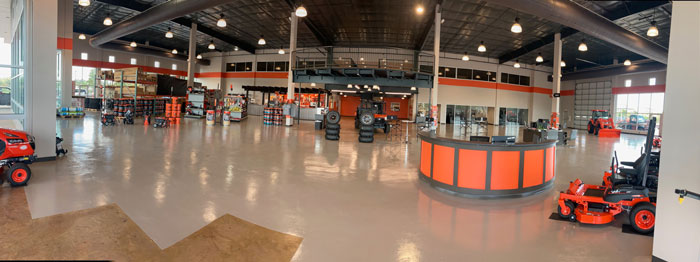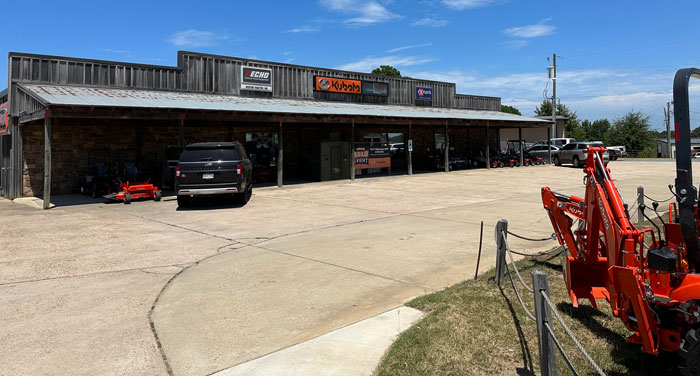As dealer consolidation shows no signs of slowing down, more dealers are facing a tough choice: get serious about growing or look at selling. The appropriate solution is different for every dealer, but Jeremy Gantt, principal at 3-store Louisiana Kubota dealer Bayou Kubota, chose to grow. Since 2019, Gantt has overseen the building of one new location and the acquisition of a third and has learned along the way what to do and what not to do.
Based on his experience, Gantt offers a series of tips for other dealers who find themselves in his position and how to ensure the success of their growth.
1. When choosing where to build, look for hidden advantages and costs
Kubota approached Bayou Kubota in late 2019 with its first growth opportunity — assuming the business of a nearby closing Kubota dealer in Monroe, La. Gantt initially contacted the nearby New Holland dealer, who was an old friend and was planning to close his dealership. Gantt bought that location, resigned the New Holland contract and hired the former owner as the general manager. However, Kubota had already told him they’d need a new building before long.
Gantt identified two options: a former Pontiac dealership in town and a 10-acre plot of farmland outside the town. When looking at the Pontiac dealer’s location, Gantt’s contractor saw “endless possibilities,” but Gantt saw “$450,000 worth of drainage buried under the ground that nobody will ever see but will cost us.”
The contractor initially brought up concerns with the farmland plot, including asbestos and rust. Gantt ultimately went with the plot of farmland, saying, “I saw drainage in place, and I saw red iron already hung.”
Another advantage to the farm plot location was being right off Interstate 20, which meant the I-20 economic development board built Gantt a road to connect the new building to an existing road.
2. Use an engineering firm vs. an architect when possible
Gantt recommends dealers looking to build start with their OEM’s guidelines, which can still be modified based on need.
“The manufacturers all have an idea of what they want and how they want things to look,” says Gantt. “As a dealer, you can take those plans and modify them and move them around. But there’s a lot of monetary value in having a profile already in place, especially if you don’t have an idea of what you want to do. We worked with a company Kubota had already partnered with, used some of our Kubota Elite funds to get them to come down, do some consulting and give us a mockup plan.”
After getting this mockup, Gantt went through an engineering firm for the modifications to the building plan, which saved him considerable money vs. using an architect.
“To have the mockup stamped for the architecture is about $250,000 more,” he says. “Basically what you get is the architect’s drawing. You’ll have painted trees, and it’ll be pretty. The engineering drawing will just be engineering, pretty simple.”
3. Construction isn’t getting cheaper
Gantt admits that at one point in the building process, in late 2020, he paused his plans due to the rising cost of construction, hoping the prices would come down. Unfortunately, they didn’t. His advice is to do the research and start building now before prices go up even further.
“Our first bid was about $2.5 million, and that was the middle to late part of 2020,” Gantt says. “I looked at it and said, ‘There’s no way we should try to build this building. We don’t have enough inventory. We’re going to hold off as long as we can push Kubota.’
“So later when inventory’s coming back and Kubota’s back to asking, ‘Where are we at? When are you going to get started?’ now it’s about $3.4 million. In that span of 19-25 months, it’s gone up about $900,000. Everybody says, ‘Well, it might go down.’ Well, it’s probably not, especially with interest rates.”
4. Plan ahead for interesting municipality requirements
In September 2021, before the Monroe location was even finished, Kubota approached Gantt about expanding into a new territory in Northwest Louisiana. Kubota accepted his business plan for the territory and Gantt found himself needing to find another store, which he found in a former boat dealership.
“Now I’ve got to find a building, and I can’t wait,” he says. “I don’t have time to build. I don’t want to go somewhere that’s not permanent. Luckily, I walked into a situation where there was a boat dealer that had gone out of business several years ago, and they had built this Taj Mahal of a dealership.”

13,000 square foot showroom at the new facility. Photo: Bayou Kubota
This location had a 13,000-square-foot showroom, an 11,000-square-foot shop and 4 acres of asphalt. Bayou Kubota submitted its proposal to the building owner, and right when it was starting to move forward, the dealership encountered an unlikely obstacle: the Bossier City Beautification Project.
“If you’re going into another town, there’s things you can do as a dealer to learn upfront what’s about to be required,” he says. “There were 25 crepe myrtles that had to be planted and 114 bushes and a sprinkler system that had to work to keep them all alive to qualify for a permit through the Beautification of Bossier City. We’re 2 miles off the interstate, and we’re still required.”
Gantt views these types of requirements — putting up lights, having a certain number of parking spaces or a certain amount of green space — as a sunk cost. “All of those things are going to cost you money that you’re not necessarily going to recuperate,” he says. “I haven’t heard anybody yet come to the Bossier City store and compliment us on our crepe myrtles, but they’re there.”
5. Sometimes you have to poach a ‘whale’ for a new location
Bayou Kubota’s third location in Bossier City started with 1 employee who was relocating from the original Ruston store. Gantt knew when putting together his hiring plans that he’d need a “whale.”
“I had to have somebody on day #1 who brought credibility and understanding,” Gantt says. “I had to go find that person, and I had to go take them from another dealership. I couldn’t hire somebody from the car business or from Lowe’s or Home Depot.”
Gantt ended up going to a childhood friend — someone he’d graduated college with and rodeoed with — to run the store. He worked for one of Bayou Kubota’s competitors with a long line of people ahead of him for promotion.
“Once it became clear we were going to get the nomination for the Northwest territory, we finalized the deal and hired him,” he says. “And honestly, it sent out ripples because he had worked for our competitor for 19 years, and they were pretty secure in the fact that he was always going to be there. He was one of their top producers. The opportunity for him to run a store was just the next step in his career. Where he was, there were just too many people in line ahead of him.”
While Gantt doesn’t directly reach out to his competitors’ staff looking to hire them, he makes an effort to market to them through social media and Indeed.com.
“The biggest challenge going into multiple locations is keeping everybody going the same direction…”
“If they’re on Indeed, then there’s a problem because people don’t necessarily want to jump jobs,” Gantt says. “I know the industry average now says that people are changing jobs 16 times before they’re 50 years old. I think a lot of that is because they don’t know what they want to do. If you’ve got a young technician, they want to work on equipment. Those guys tend to come and stay if they’re taken care of.”
In the context of opening a new store, Gantt’s mentality is that if he hadn’t poached a rival dealers’ employee, it’s likely that employee was going to head somewhere else anyway.
“When you’re trying to acquire help at a new location that’s from the ground up, I would be careful,” he says. “Get ready for some phone calls, get ready for some people to get their feelings hurt that you hired somebody from them, but understand that if you didn’t solicit them, then chances are they wanted to make a change anyway.”
6. Train staff ahead of time to relocate to a new store
The 1 employee Bayou Kubota opened its Bossier City store with, aside from the new general manager, was a parts employee who had relocated from another store. Gantt recommends dealers ask staff if they might be interested in a new opportunity at a new store and give them the training they need to succeed there.
“When we got the call that we could potentially be in Bossier City, we started training a guy who was in parts,” Gantt says. “We went to every employee we had and asked if they wanted to move to Bossier City. It’s 65 miles west of us. There’s people who can and can’t move. But we found a guy who wanted to take on that challenge.
“I said, ‘OK, then you need to start ordering. You need to start looking at your fill rates. You need to start looking at your freight. You need to learn the system more than just being able to help a person at the counter.’ And so we had 4 months of him taking on more of the parts manager role before he moved.”
7. Don’t forget about your ‘home team’
As Bayou Kubota moved from 1 to 3 locations over the course of a few years, Gantt recognized the effort his first location’s staff in Ruston was putting into the success of the other stores.
“The biggest challenge you have going into multiple locations is keeping everybody going the same direction,” he says. “I never realized the amount of calls the other locations were getting and then asking the Ruston store for answers.
“You start telling everybody, ‘Oh man, Monroe is doing great. The parts department’s knocking it out of the park, and they’re doing this and that. And they acquired this new customer the other day.’ And your home team is thinking, ‘Well, yeah, that’s because I told them what to do. I got them through that process, told them how to price it, etc.’”

Ruston Tractor’s original location in Ruston, La. Photo: Ruston Tractor
It boils down to simply remembering to recognize the successes of all your locations’ teams, even when your attention might be focused more on the newer stores. There’s also something to be said for customers moving between locations as new ones open (for convenience), which may give the appearance of your older stores losing business.
“Chances are, if you are close enough in proximity, your home sales for the first year are going to go down,” he says. “Our Ruston sales took a step back the first year we opened Monroe in terms of parts and wholegoods volume. And when we opened Bossier, Ruston took another step back because customers were going, ‘Oh, it’s you guys. Yeah, I’ll come do business here instead of driving to Ruston or Monroe.’
“If you’re not careful, you’ll end up telling your home team they aren’t doing as well as the other locations,” Gantt says. “The reason everybody else is doing well is probably because of that home-team atmosphere. Be really aware of that and try to pump those guys up. Make sure they understand that as a team, those other guys will call and they need help, give them good information and work with them through those things.”







